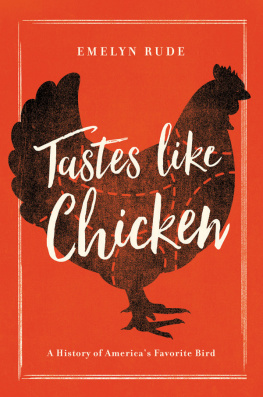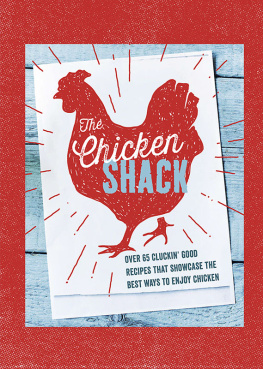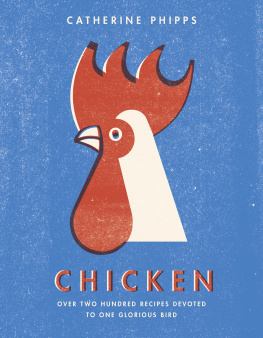

TASTES LIKE CHICKEN
Pegasus Books Ltd.
148 W 37th Street, 13th Floor
New York, NY 10018
Copyright 2016 Emelyn Rude
First Pegasus Books edition August 2016
Interior design by Maria Fernandez
All rights reserved. No part of this book may be reproduced in whole or in part without written permission from the publisher, except by reviewers, who may quote brief excerpts in connection with a review in a newspaper, magazine, or electronic publication; nor may any part of this book be reproduced, stored in a retrieval system, or transmitted in any form or by any means electronic, mechanical, photocopying, recording, or other, without written permission from the publisher.
Library of Congress Cataloging-in-Publication Data is available.
ISBN: 978-1-68177-163-2
ISBN: 978-1-68177-198-4 (e-book)
Distributed by W. W. Norton & Company
To my family, the strangest and most wonderful flock of them all
CONTENTS
O nce, in my student days, a very serious scholar with a very serious mustache at a very serious university looked up at me sternly from a pile of worn treatises on the nature of human progress and mused, a chicken is an incredible piece of technology.
Even as just a bird, a chicken is an incredible thing. With a population of more than 50 billion, the chicken is the most abundant feathered species on the planet. It thrives on all six major continents, from Iceland to Patagonia, in deserts and forests, on mountain peaks, and in the midst of cities. Thanks to the Chinese, some chickens have even been to space. As the bird can be quarrelsome at times, archeologists believe that the chicken was first domesticated for cockfighting and that the fowl is also a proud descendant of the sharp-toothed and short-armed Tyrannosaurus rex . When chickens sleep they sometimes dream, and in their home flocks, the birds can recognize each others faces. Most incredible of all, a chicken also makes a great chicken dinner.
The methods humans have devised to prepare and enjoy this fowl are almost as abundant as the bird itself. Hungarians like to braise it into paprikash , the Senegalese stew it with peanuts and serve it over rice, Mexicans coat it with fiery mole verde and like to have a good laugh when foreigners cant handle the heat. All across the globe chicken is skewered and roasted and steamed and jerked, pounded paper thin and coated with breadcrumbs or chopped into little bits and fried up with potatoes. Theres no other ingredient quite like ita food so universal that when you say something tastes like chicken, almost everyone on the planet will have some idea of what you are talking about.
As a result, most people across the globe would be excited to chow down on the aforementioned fowl-filled menu, but I am unfortunately not one of those people. I am undoubtedly committing the cardinal sin of food writing by telling you this up front, but I am a chicken historian who does not actually like eating chicken. In fact, Ive never liked eating chicken (or eating much other meat for that matter). From the time I was very young, there was always something about the texture of flesh, and the idea of the animals behind it that I just couldnt stomach. As a result, some of my earliest memories involve sobbing mournfully at the dinner table while my mother patiently held forth a chicken skewer or a fish stick or a beef taco she expected seven-year-old me to eat. (Spoiler: I never ate them.)
While I no longer cry (that often) while dining and am gradually becoming a more flexible eater following almost two decades of vegetarianism, I still rarely eat chicken. Even after working for some very talented chefs in New York City, and expanding my tastes to include olives of all kinds, thinly sliced hams, and briny oysters on the half shell, in my personal hierarchy of delicious things, the bird is still toward the very bottom.
In this preference, I am clearly very alone. Walk into almost any kitchen or restaurant in the United States and you will encounter a seemingly endless stream of grilled chicken breast and fried chicken and chicken enchiladas and chicken Caesar salad and chicken teriyaki and spicy chicken wings. When one quantifies this incredible fowl cornucopia, my particular eating habits seem even more unusual. Although the world knows my fellow Americans as passionate beef eaters, the citizens of the United States are actually the worlds biggest and most prolific eaters of chicken.
Even with people like me skewing the data, in 2015, the average citizen of the United States still consumed over ninety pounds of chicken, which translates to roughly twenty-three birds per person. and comprises almost a full third of the 27 billion chickens eaten in any given year across the globe.
While the sheer scale of Americas chicken consumption is incredible to think about, it is even more astonishing considering the fact that these eating habits are entirely new. Well up to the early twentieth century, the average American ate just ten pounds of chicken each year, which meant a family was lucky to have chicken on their plates even once a week for the fabled Sunday Supper. In fact, for most of Western history, chicken was not even considered a meat (more on this later), and instead it was beef that wound up at the center of American dinner plates for most of the nations history.
Observing this dramatic shift in the countrys eating habits, as a culinary historian, the question I have to ask is: Why? Seriously. Why do Americans today eat so much damn chicken? If youre anything like my brother, my friends, or my coworkers, chicken is whats for dinner four or five nights per week and whats for lunch most days in between. If youre the man who helped me sign up for my gym membership or the businesswoman I spoke with briefly on the subway, you eat chicken to the point of boredom, go search for something else to eat, and then end up eating more chicken. Never before in modern history has a food risen so quickly in national eating favor and never before has any country consumed such prodigious amounts of poultry to the point of almost excess.
Raised by two agricultural economists, Ive always known theres much more to a dish than what meets the plate. And so I began my search, through cookbook archives and agricultural manuals and the results of poultry science experiments, to unravel the mystery of how red-blooded Americans came to be eating such large quantities of white-meat chicken. The results of this hunt are what you now hold in your hands.
Painted in broad strokes, this is a story of agricultural science and human health, of the economics of feeding a nation and the politics that encircle the making and eating of a food. But on a more intimate level, this is really just the story of dinner. As it has been roasted, baked, boiled, and fried in kitchens across the whole of American history, the chickens role on the nations plates has been ever changing. Each generation had their own way of raising, cooking, and enjoying the bird and, in turn, their own understanding of what exactly tastes like chicken. And so, my sweet readers, without any further ado, let us sharpen our proverbial knives, prepare our historical palates, and dive right into this tale of making and eating a meat in America.
A CHICKEN PIE
Pick and clean six chickens, (without scalding) take out their inwards and wash the birds while whole, then joint the birds, salt and pepper the pieces and inwards. Roll one inch thick paste No. 8 and cover a deep dish, and double at the rim or edge of the dish, put thereto a layer of chickens and a layer of thin slices of butter, till the chickens and one and a half pound butter are expended, which cover with a thick paste; bake one and a half hour.
Next page










